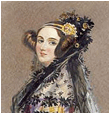Augusta Ada King (Née Byron), Lady Lovelace
Born December 15, 1815, London, England; died November 1852, London, England; student, friend, confidante, and interpreter of the work of Charles Babbage, and the first conceptual programmer of his Analytical Engine.

Ada was a gift from the gods to so rigorous a subject as the history of mathematics (or computer science). Beautiful, charming, temperamental, her own life a minor tragedy, as Byron's daughter she acquired the romance that attaches to everyone associated with that magnificent poéte maudit.
Ada's mathematical work does not provide her with a position in the history of mathematics, except for her association with Charles Babbage. Ada's mother, the odious Lady Noel Byron, took her to Babbage's house in 1833, but it was only some years after Ada married Lord King (later Earl of Lovelace) that she began to see a great deal of Babbage. He was addicted to the company of beautiful and intelligent women, and for more than a decade she played an important part in his life.
Ada was an enthusiastic student of mathematics, becoming proficient at a time when it was exceedingly rare for a woman to do so. She was an aristocratic hostess; the mathematicians of the day were fascinated. There is no evidence that she ever did any original work in mathematics; all that remains are her student exercises. If she did attempt anything it was probably developed in the "Book," her mathematical scrapbook, long since disappeared, which passed back and forth between her and Babbage. But she translated and made extensive notes to Count Menabrea's famous paper on Babbage's calculating engines. [General Luigi F. Menabrea learned of Babbage's machines during the latter's visit to Italy; he published his report in Italian in 1842. Menabrea was later prime minister of Italy.] These notes were made under Babbage's careful supervision, and Babbage himself carried out the calculation of the Bernoulli numbers contained therein. Thus her notes are by far the most important statement we possess of Babbage's views on the general powers of the Analytical Engines. [Based on Anthony Hyman's review of Moore 1977, which appeared in Ann. Hist. Comp., Vol. 1, No. 1, 1977, p. 75.]
It has been suggested that Ada was interested in using the Analytical Engine to derive some advantage in betting on horse races, but this has been refuted. [See biography of Charles Babbage.] She died of cancer at the same age as that of her father when he died; although she had never met him she requested to be buried alongside him.
QUOTATION
"We may say most aptly that the [Babbage's] analytical engine weaves algebraic patterns just as the Jacquard loom weaves flowers and leaves. "
BIBLIOGRAPHY
Biographical
Elwin, Malcolm, Lord Byron's Family: Annabella, Ada and Augusta, 1816-1824, John Murray (Publishers), London, 1975.
Huskey, Harry D., and Velma Huskey, "Lady Lovelace and Charles Babbage," Ann. Hist. Comp., Vol. 2, No. 4, 1980, pp. 299-329.
Huskey, Velma R., "Lovelace, Countess of," in Ralston, Anthony, and Edwin D. Reilly, Jr., Encyclopedia of Computer Science and Engineering, Van Nostrand Reinhold Co., New York, 1983.
Moore, Doris Langley, Ada, Countess of Lovelace: Byron's Legitimate Daughter, Harper and Row, New York, 1977.
Significant Publications
King, Augusta Ada, "Addition to the Memoir of M. Menabrea On the Analitical [sic] Engine," Philosophical Magazine, Vol. 23, Sept. 1843, pp. 235-239.
UPDATES
The original author is mistaken in noting "Née Byron" in her name. She was certainly the daughter of the poet Lord Byron, but "Lord Byron" is a title, not a name. His name was actually "George Gordon, the Lord Byron" so his daughter's surname was Gordon, not Byron. When she married William King (8th, Baron King) she became Augusta Ada King (properly noted above) and when he became the 1st Earl of Lovelace, she became Augusta Ada King, the Countess of Lovelace (occasionally known as Lady Lovelace). (MRW, 2012)
Portrait inserted (MRW, 2013)
New content Copyright © 2013-2023 by the IEEE Computer Society and the Institute of Electrical and Electronics Engineers Inc.
All rights reserved. This material may not be reproduced or redistributed without the express written permission of the copyright holder.
